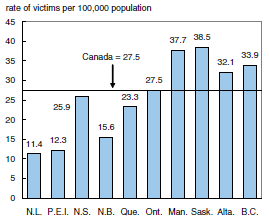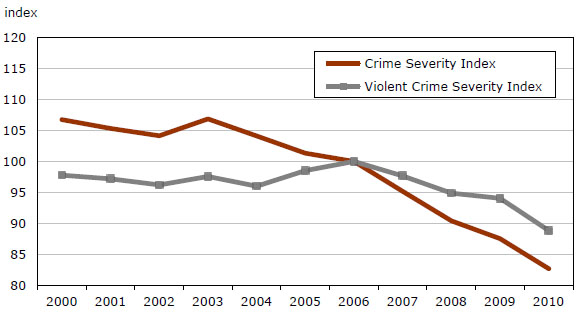| Latest | Greatest | Lobby | Journals | Search | Options | Help | Login |
|
|
|
| Home » Discuss » Topic Forums » Guns |
|
| iverglas
|
Sun Aug-28-11 04:06 PM Response to Reply #120 |
| 128. one small component of the data |
|
One claim is that while homicide rates are vastly lower in places like the UK than in the US, "violent crime" rates are not.
These rates conceal some interesting facts, specifically: homicide in the course of another crime. In those cases, the event is categorized as a homicide and does not show up in, say, robbery figures. (My emphases throughout the excerpts below.) http://aic.gov.au/publications/current%20series/tandi/241-260/tandi252/view%20paper.aspx (Australia, 2002; long paper so the following is fair dealing/use) ... Homicide is a multifaceted crime, and policies oriented to prevention must be built on solid data and a clear understanding of the various characteristics of homicide and situations in which it might occur. This paper focuses on one such situation: homicide incidents that occur in the course of other crime (for example, during a robbery or a sexual assault). Of the 4,108 homicide incidents that occurred in Australia between 1989 and 2002, 542 (13 per cent) occurred in the course of another crime. These incidents differ significantly from "non-crime" homicide incidents. ... In recent years there has been a dramatic increase in the rate of robbery in Australia2 (Mouzos & Carcach 2001). In contrast, the rate of robbery-homicide has remained relatively stable over the same period (see Mouzos 2000, p. 74), suggesting that the robbery-homicide trend does not follow the robbery trend in Australia. While there appear to be differences in the incidence rates of the two types of crime, few studies in Australia or elsewhere have examined the proposition that robbery-homicide is a by-product of robbery, and that the only difference between the two is that robbery-homicide results in the death of the victim whereas robbery does not. One of the few studies that has addressed this question found that robbery-homicides are more similar to other robberies than to other homicides, offering support to the contention that robbery-murder is an intrinsic by-product of robbery rather than a different offence altogether (Cook 1987). This dearth of research leaves many questions unanswered. For example, are the offences of robbery and robbery-homicide essentially similar behaviours that differ principally in outcome rather than in process? Is the typical robbery-homicide most appropriately considered a fatal robbery, or are lethal robberies quantitatively different from non-lethal robberies? ... The comparative analysis of crime homicides and other homicides in Australia reveals a number of noteworthy differences. Compared to other homicides, Table 1 indicates that crime homicides were significantly more likely to: ... involve a weapon other than a knife or other sharp instrument (firearm, assaultive force, blunt instrument); ... ... While firearms were one of the least commonly used weapons in both robbery and robbery-homicide, the higher use of firearms in robbery-homicide may increase the risk of lethal injury. Zimring (1991) refers to this as the "instrumentality effect". According to this explanation, the likelihood of serious injury or death increases with the lethality of the weapon. Hence, when weapons such as firearms are used, there is a greater likelihood that the victim will be killed than when other weapons or physical force are used (see also Allen 1986; Cook 1980, 1985, 1987, 1990; Felson & Messner 1996; Skogan 1978). This would explain why the greater use of firearms in a robbery-homicide contributes to a higher proportion of deaths than in a robbery. http://www.rcmp-grc.gc.ca/cfp-pcaf/res-rec/comp-eng.htm (Canada, 1998) ... Handgun homicide rates are 15.3 times higher in the United States than in Canada. For 1989-95, the average handgun homicide rate was 4.8 per 100,000 in the U.S., compared to 0.3 per 100,000 for Canada. Handguns were involved in more than half (52%) of the homicides in the U.S., compared to 14% in Canada. ... Between 1987 and 1996, firearm homicide rates increased in the United States but decreased in Canada. During this period, the overall homicide rates decreased in both the U.S. and Canada-11% and 13% respectively. The U.S. firearm homicide rates increased 2%, compared to a 7% decrease in Canada. A greater proportion of robberies in the United States involve firearms. For 1987-96, 38% of robberies in the U.S. involved firearms, compared to 25% in Canada. Furthermore, the proportion of robberies involving firearms shows an increasing trend in the U.S. (from 33% in 1987 to 41% in 1996), compared to a decreasing trend in Canada (from 26% in 1987 to 21% in 1996). Firearm robbery rates are 3.5 times higher in the United States than in Canada. For 1987-96, the average firearm robbery rate was 91 per 100,000 in the U.S., compared to 26 per 100,000 in Canada. Rates for all robberies are 2.4 times higher in the United States than in Canada. For 1987-96, the average robbery rate was 238 per 100,000 in the U.S., compared to 101 per 100,000 in Canada. https://www.ncjrs.gov/app/publications/Abstract.aspx?id=102807 (US, 1986, abstract only) (United States) ... A final study used Detroit data to examine the role of weapons and robbery homicide. The use of guns was strongly associated with the incidence of robbery homicide. ... http://en.wikipedia.org/wiki/Gun_violence_in_the_United_States (United States) In the United States, a quarter of commercial robberies are committed with guns.<48> Robberies committed with guns are three times as likely to result in fatalities compared with robberies where other weapons were used,<48><49><50> with similar patterns in cases of family violence.<51> Criminologist Philip J. Cook hypothesizes that if guns were less available, criminals may likely commit the crime anyway but with less-lethal weapons.<52> He finds that the level of gun ownership in the 50 largest U.S. cities correlates with the rate of robberies committed with guns, but not overall robbery rates.<53><54> A significant number of homicides result as a by-product of another violent crime which escalates, with the offender going into the crime without a clear or sustained intent to kill or be killed.<50><55> <48> Cook, Philip J. (1987). "Robbery Violence". Journal of Criminal Law and Criminology 70 (2). NCJ 108118. <49> Kleck, Gary, K. McElrath (1991). "The Effects of Weaponry on Human Violence". Social Forces (Social Forces, Vol. 69, No. 3) 69 (3): 669692. doi:10.2307/2579469. JSTOR 2579469. NCJ 134329. <50> Zimring, Franklin E. (1972). "The Medium is the Message: Firearm Caliber as a Determinant of Death from Assault". Journal of Legal Studies 1: 97123. doi:10.1086/467479. NCJ 47874. <51> Saltzman, L., J.A. Mercy, et al. (1992). "Weapon Involvement and Injury Outcomes in Family and Intimate Assaults". Journal of the American Medical Association 267 (22): 30433047. doi:10.1001/jama.267.22.3043. PMID 1588718. <52> Cook, Philip J., Jens Ludwig (2000). "Chapter 3". Gun Violence: The Real Costs. Oxford University Press. ISBN 0-19-513793-0. <53> Cook, Philip J. (1979). "The Effect of Gun Availability on Robbery and Robbery Murder: A Cross-Section Study of Fifty Cities". Policy Studies Review Annual 3: 743781. <54> Kleck, Gary (1997). Targeting guns: Firearms and their control. Aldine de Gruyter. ISBN 0202305694. <55> Zimring, Franklin E., Gordon Hawkins (1997). Crime Is Not the Problem: Lethal Violence in America. Oxford University Press. ISBN 0195131053. http://www.statcan.gc.ca/pub/85-002-x/2008002/article/10518-eng.htm (Canada) In 2006, 14% of all victims of robbery faced a firearm, usually a handgun. A knife or other type of weapon was used in just over one-quarter (27%) of robberies, while no weapon (eg. threat or physical force) was used in almost half of robberies (Table 1). While robberies with other types of weapons also declined during the 1990s, this decrease was less than the decline in robberies with a firearm (Chart 5). http://www.statcan.gc.ca/pub/85-002-x/2010001/article/11115-eng.htm Despite the inherently violent nature of robbery, most incidents do not result in physical injury to victims. In 2008, 98% of victims suffered little to no injury. However, 2% of victims required professional medical attention at the scene of the incident or transportation to a medical facility. Information from the Homicide Survey indicates that there were 20 homicides that occurred during the course of a robbery in 2008, representing about 3% of all homicides. So my thesis is that homicide figures in the US mask a higher (armed) robbery rate than is apparent from the robbery figures. The same cannot be said of Australia, the UK and Canada, where robberies less often involve firearms and less often result in homicide, to anywhere near the same degree. Just one more reason why comparisons of violent crime rates are sometimes comparisons of apples and oranges. (Another main reason is that Canada and the UK, at least, include minor assaults in "violent crime" while the US does not; also, the offence of "rape" does not exist in Canada, and Canadian figures for sexual assault offences cannot be compared with other countries' figures for rape offences.) I'm just going to throw this in too, from the above Stats Can page: Chart 6 Firearm-related violent crime by province, 2006  All Western provinces, where the household firearms ownership rates are hightest, the bastion of gun militancy (those law-abiding gun owners!) and Conservative Party voting, have higher rates of firearm-related violent crime than all Eastern provinces (except Nova Scotia, an odd case because of a spate of firearms robberies in Halifax, the population being small enough that rates are easily affected by single-digit occurrences). This is also worth noting: http://www.statcan.gc.ca/pub/85-002-x/2011001/article/11523-eng.htm Chart 2 Police-reported crime severity indexes, Canada, 2000 to 2010  And just because it's so pretty: Chart 4 Homicide by method for selected countries, 2006  |
| Printer Friendly | Permalink | Reply | Top |
| Home » Discuss » Topic Forums » Guns |
|
Powered by DCForum+ Version 1.1 Copyright 1997-2002 DCScripts.com
Software has been extensively modified by the DU administrators
Important Notices: By participating on this discussion board, visitors agree to abide by the rules outlined on our Rules page. Messages posted on the Democratic Underground Discussion Forums are the opinions of the individuals who post them, and do not necessarily represent the opinions of Democratic Underground, LLC.
Home | Discussion Forums | Journals | Store | Donate
About DU | Contact Us | Privacy Policy
Got a message for Democratic Underground? Click here to send us a message.
© 2001 - 2011 Democratic Underground, LLC